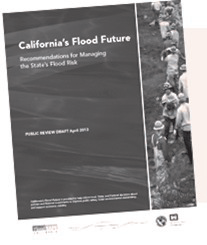DEPARTMENT OF WATER RESOURCES, U.S. ARMY CORPS OF ENGINEERS
Agencies Place New Focus On Flood Risks
Flooding may not be much on the minds of Californians as a second consecutive much below average rain and snow season winds down but the state’s flood risk is very high, state and federal agencies say.
The state Department of Water Resources and the U.S. Army Corps of Engineers on April 3 issued a report in which they contend statewide flood management efforts are fragmented as well as lacking stable funding, co-operation between agencies or even focus.
 The report urges the state to coordinate, streamline or consolidate 1,343 agencies that deal with flood management.
The report urges the state to coordinate, streamline or consolidate 1,343 agencies that deal with flood management.
Along the southern San Joaquin Valley’s East Side, the pre-eminent flood management agency is the Corps of Engineers, which operates several reservoirs that have flood control as a primary function.
Those include the Kings River’s Pine Flat Dam, the Kaweah River’s Terminus Dam, the Tule River’s Success Dam, the Kern River’s Isabella Dam, the Fresno River’s Hidden Dam and the Chowchilla River’s Buchanan Dam.
DWR’s oversight includes the state Division of Flood Management and several valley flood management projects.
Kern, Tulare, Fresno and Madera counties all have some sort of flood control agency or staffing and the Fresno-Clovis area has a full-fledged urban flood control agency. The Kings River Conservation District also has an extensive flood protection operation.
DWR is accepting written comments on the public review draft of California’s Flood Future: Recommendations for Managing the State’s Flood Risk until May 20. One of a series of statewide workshops will be held from 2-4 p.m. May 9 at the Fresno County Farm Bureau office in Fresno.
“The stakes are tremendous,” said Terri Wegener, DWR flood management manager.
The report is said to be the most comprehensive statewide study of flooding ever conducted
It says 7.3 million Californians – 19% of the population – are exposed to significant flooding risk. Damage to structures and farmland could be as high as $575 billion statewide. Agriculture’s exposure amounts to more than $7 billion in crop values.
“There is risk everywhere,” said Kim Carsell, a Corps of Engineers water resource planner.
The report recommends:
• Conducting regional risk assessments.
• Improving public understanding of flood risks.
• Increasing funding for flood preparedness, response and recovery.
• Promoting land-use planning that reduces flood dangers.
• Using regional or statewide focus, rather than local, in flood management projects.
• Increasing collaboration among agencies.
• Establishing adequate and stable funding.
The report identifies some $50 billion in projects either under construction or in various stages of planning but concludes such an amount is insufficient.
